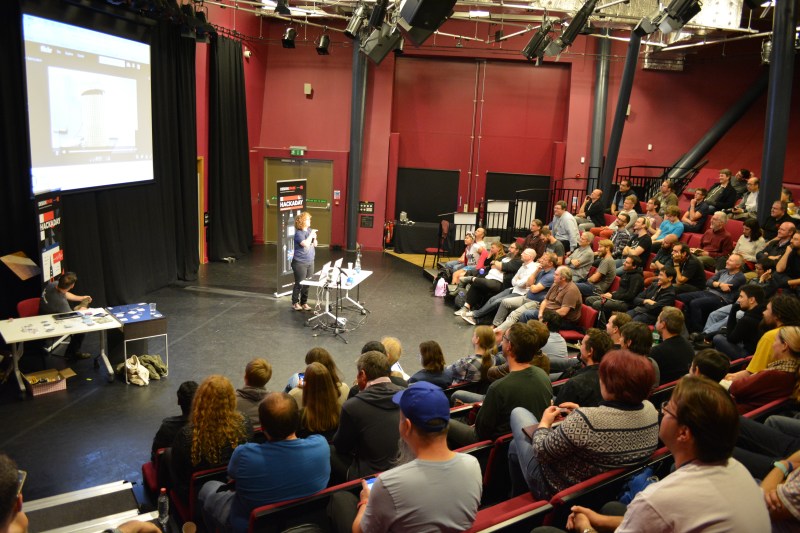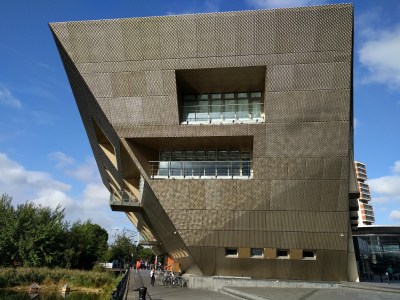A trip to London, for provincial Brits, is something of an undertaking from which you invariably emerge tired and slightly grimy following your encounter with the cramped mobile sauna of the Central Line, its meandering international sightseers, and stampede of besuited commuters heading for the City. Often your fatigue after such an expedition will be that following the completion of a Herculean labour, but just sometimes it will instead be the contented tiredness of a fulfilling and busy time well spent.
Such will be the state of the happy band of the Hackaday community who made it to London this weekend for our UK unconference held in association with our sponsor, DesignSpark. A Friday night bring-a-hack social in a comfortable Bloomsbury pub, followed by Saturday in an auditorium next to one of the former Surrey Commercial Docks for a day of back-to-back seven-minute talks laying out the varied and interesting work our readers are involved in.

“Varied and interesting” does not even begin to cover the breadth of projects, and expertise covered by you, our readers. It is a constant surprise and delight as a Hackaday editor to see new and interesting fields covered through Hackaday.io projects, and that diversity carried through into this event, with a continuous flow of speakers covering everything from digital privacy through laser-enhanced Nintendo zappers and robotic telepresence devices to stem cell research. We love our community!
The trouble is, with so many attendees and so many high-quality talks, where do we start in trying to describe them? It is probably best then to present an overview from a personal viewpoint, those talks that most stuck in my mind, and to present my apologies to those others who I simply don’t have the space in which to mention.

Perhaps the best place to start as a hardware enthusiast is with the three PCB-related speakers to whom I would have gladly listened to for far longer than the allotted seven minutes. [Saar Drimer] is a name some of you may recognise from his professional life as the Boldport electronic design agency, and he had brought along a variety of his more artistic work including a super-sized PCB for a museum display and a PCB trophy he’d created in the past for our sponsor. His talk though covered the ingenious design of his Monarch soldering kit, a PCB flashing-light butterfly.
[Roger Thornton] is someone whose work you may well be familiar with even if you do not immediately recognise his name. As the Raspberry Pi Foundation’s principal hardware engineer it is his hand you see on a Raspberry Pi board, and his talk gave us a unique insight into the design of the Raspberry Pi Zero. Fitting a wireless chipset onto an already tiny board while keeping components on only one side and costs to a minimum turns out to be a task fraught with difficulty.
![[Mike]'s super-tiny electric stuff](https://hackaday.com/wp-content/uploads/2017/09/mikes-electric-stuff-screen.jpg?w=400)
Security and privacy talks also featured on the agenda, with [Joe Fitz] showing us why not even hardware-based two-factor authentication should be viewed as entirely trustworthy, with a beautifully-executed little wireless backdoor PCB for those RSA SecurID tokens. Then [Dana Polatin-Reuben], whose day job is with Privacy International, laid out some of the more chilling aspects of the ubiquitous data collection by manufacturers of IoT devices.
![[Ales Eames] and his bicycle turn signal](https://hackaday.com/wp-content/uploads/2017/09/alex-eames-lights.jpg?w=400)
We had some robotics talks, [Libby Miller] demonstrated her [LibbyBot], an engaging telepresence bot created using an IKEA lamp, and [Neil Lambeth] gave us the low-down on robot football, with of course a supporting cast of robots.
As a Hackaday editor it was particularly good to meet some of the rest of the team, as we are spread across the globe. Our editor-in-chief [Mike Szczys] told us about his work on digital logic from first principles with discrete components, while managing editor [Elliot Williams] showed us his flip-dot display talk timer, unusually programmed in FORTH. Meanwhile our contributor-at-large [Alasdair Allan] delivered a cautionary tale on the dangers of trusting IoT data, and contributor [Adil Malik] showed us his rather beautiful three-phase power monitor. Then when it was my turn, for some light relief I eschewed hardware projects, and entertained the masses with a tale about cider.

Finally, a notable talk came from [James Larsson], who you may recognise as the originator of the Flashing Light Prize. He had an announcement, of the 2018 contest, which must involve neon lamps and a 1 Hz flash rate with a 50% duty cycle. Hackers, start your oscillators!
So the crowd that spilled out of the auditorium into the September night and made their way across to a nearby pub came away having had an edifying and entertaining day. There were people from all sides of our community present, people whose work we’d featured, and readers who had made the trek to London simply for the spectacle. We settled down for an evening of socialising over a pint or two of rather good craft ale, we Hackaday staffers having something of a need to relax after a day on our feet.
 On behalf of Hackaday I’d like to extend our thanks to our sponsor DesignSpark, who made it possible to run a conference without charging for tickets, Canada Water Culture Space, whose staff provided the support that ensured everything ran smoothly, and finally to you, our readers and attendees. You make us who we are, and events like this one allow us to better remain in touch with you.
On behalf of Hackaday I’d like to extend our thanks to our sponsor DesignSpark, who made it possible to run a conference without charging for tickets, Canada Water Culture Space, whose staff provided the support that ensured everything ran smoothly, and finally to you, our readers and attendees. You make us who we are, and events like this one allow us to better remain in touch with you.
Our next global event will be the upcoming Hackaday Superconference in California in November. Our British readers can rest assured that this will not be the last time you will see us.
















Thanks to all the organisers and presenters. A really great Unconference!
that was one well spent day, can’t wait for the next one :D
Where are the recordings?
No recordings, on purpose. We want to keep the unconferences friendly and spontaneous, and not everyone is ready to be up all over the internet. It worked really well, IMO. It _is_ a bummer for everyone who wasn’t there, but it also enabled folks to speak who wouldn’t have otherwise. It’s a tradeoff.
OTOH, the upcoming Supercon talks are all going to be recorded and will be all up on a website near you.
Will be very interested in Roger Thornton recordings – I was wondering about how hard it was to design the Zero W myself =)
in a nut shell : “It was hard.”
A slightly larger nutshell: they had size, cost, and parts availability constraints. They got to hone their WiFi design on the RP3, and then basically port that over to the Zero, but still making it all work on a single-sided design (cost) is quite a feat. The Zero was already small, and they had to shrink it to fit the WiFi.
I got the impression that they’re continually learning and refining over there. The design wins from one generation influence the next, etc. Not unlike the way any of us work, honestly…
Exactly this. The Zero W has a new antenna, which is apparently better than the ceramic one from Pi 3. So i wouldn’t be at all surprised to see that on future mainstream Pi models. :)
Ireland?
Good point.
theres very little that I can see going on on this island though
I was happy to put a face on many names, including the Hackaday writers. It was a great pleasure to be there not only to present our open-source IoT platform but to discover the community and its diversity. There were talks about the failure of electronics in space, making REAL apple cider, blinking LEDs with an LFSR, simulating Appolo flight software on an FPGA, leaving kids play with fire, building a real laser Nintendo gun and more.
The 7-minute talk format is great and I will definitely use it in the future for local events!
Thoroughly enjoyed it.
I really enjoyed it. Excellent format. Thanks to all involved for making it a great day :)
Alex Eames is blogging the build process for the bike lights. Interesting to see what it took to get it working and then refining it to the point it’s at now.
Day 3 (has links to the previous 2 days) http://raspi.tv/2017/high-visibility-cycle-lights-with-raspberry-pi-esp8266-raspio-inspiring-day-3
I’ve never had the opportunity to attend these unconferences in person, unfortunately. From what I’ve read, though, they’re basically HaD articles only in person, is that right? Someone (i.e., article writer, presenter) presents a project and attendees (or HaD readers such as myself) comment and ask questions? Do attendees also shout “Not a hack!” or “That’s just an ad!” or “What a waste of a micro, should’ve just used a 555!” or “I’ve done that same thing 10 years ago!” when they’re in person? (c:
I do find the 555 timer crowd interesting. When you can get for example an ATtiny micro for almost half the cost of a 555 timer, not including the cost of the passives required for the 555 timer, it actually makes more sense to get the ATtiny. I guess there might be some advantages to 555 timers in terms of power usage. But the benefits of flexibility can significantly outweigh the ultra-minimalist.
As for the conference itself, it’s just hackers sharing hacks. Who cares if it was done 10 years ago by some guy in his garage lab, you’re sharing something with someone that is interested, and that’s what really matters. If there’s no track running with areas that interest you, get some people together and have some hallway discussions. Some of the conferences I’ve presented at were like this, the hallway discussion was the 555 timer of unconferencing.
Really ATinys are like 35 cents now?
Well okay I found them for 40, then I found 555s for 15 instead of 70
@Wretch, re: the NOTAHACK crew.
It probably _was_ just like HaD in person! But while the 555-timer fans have an over-proportional appearance here, in real life you can see all of the mainstream Hackadayers smiling, nodding their heads, and enjoying a good hack.
It’s the same online too: we get thousands and thousands of people reading any given post, most of them probably enjoying it silently, many who encourage or otherwise contribute in the comments, and then one or two folks who decide that they know it all.
99.99% of our readers are awesome, and that’s what the crowd was like at the meetup.
Definitely a generalisation based on your traditional supplier costs. When you go to quantity it gets cheaper for a generic 555 timer for blinking an LED (ignoring temperature, BOM, layout and voltage requirements either way) . But it goes to show that the venerable 555 timer really is in a sense becoming somewhat obsolete.
Ops, this was meant to be a reply to RW above.